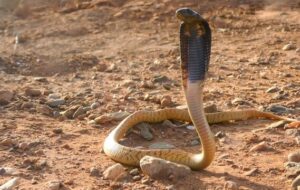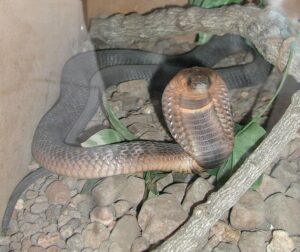
The Egyptian cobra is a venomous species and Africa’s second-largest cobra after the forest cobra. This species is also known as the Egyptian asp, derived from the Egyptian word aspis. Its Egyptian name is Ouraeus – a stylized form of this cobra that ancient Egyptians used to symbolize sovereignty and royalty. In 1758, famous Swedish zoologist Carl Linnaeus first described this species. Their genus name ‘naja‘ derives from the Latinized Sanskrit word nāgá meaning “snake”. And the species epithet ‘haje‘ derives from the Arabic word ḥayya, which also translates to “snake”.
These are nocturnal creatures but may bask in the early morning sun. They are primarily solitary and are very important for the ecosystem by controlling agricultural pests and maintaining the balance of prey species.
Egyptian cobras have a wider hood and are shorter in length compared to the king cobra, which also belongs to the Ophiophagus genus.
Scientific Classifications
- Suborder:Serpentes
- Family:Elapide
- Genus:Naja
- Species:N. haje
Conservation Status
Subspecies
The Egyptian cobra has only a single subspecies, which is found in Morocco.
- Egyptian Cobra (Naja haje legionis)
Description
Size
The average length of Egyptian cobras is about 3-7 ft (1-2 m), and they weigh about 20 lbs (9.07 kg). The longest specimen of this species recorded was 8.5 ft (2.59 m).
Color and Appearance
This snake’s color varies highly, ranging from copper-red to grey-brown to almost completely black, with the ventral side color ranging between black, blue-grey, creamy white, dark brown, grayish, and yellowish-brown, with dark spots covering it.
They have large heads which are depressed and somewhat distinct from the neck. Similar to other cobras, the Egyptian cobra can also form hoods by expanding the long cervical ribs in their neck. These snakes have cylindrical and stout bodies, slightly broad and rounded snouts, big eyes with round pupils, and long tails. A tear-drop mark is often seen below the eye.
They have 19-20 dorsal scale rows at the midbody, 191-220 ventral scales with a single anal plate, 53-65 subcaudal scales, and all are paired; there are one preocular, 2-3 postocular and 2-3 suboculars scales, eight lower labials, and 1+2 or 1+3 temporal scales, that varies depending on the specimens.
Are they Dangerous
This species is among the most venomous snakes in the world, with an LD50 value of 0.42 mg/kg and a yield of 175-300 mg per bite. Unlike some other snakes, these cobras cannot spit venom, but their bite is still highly effective. It is a combination of cytotoxins and neurotoxins, which cause abdominal pain, blistering, bruising, collapse or convulsions, nausea, necrosis, pain, swelling, vomiting, and sometimes moderate to severe flaccid paralysis. The venom attacks the victim’s nervous system by affecting the transmission of nerve signals to the muscles and eventually stops these signals from reaching the heart and lungs, causing complete respiratory failure and leading to the victim’s death.
According to a study, the venom of northern African specimens, primarily from Algeria, Egypt, Libya, and Tunisia, is more potent than those found in southern and western parts of the continent, which includes Mali, Nigeria, Senegal, and Sudan.
The Egyptian cobras are extremely shy and usually try to avoid humans or escape if approached. But some specimens near human settlements tend to enter houses, especially those with abundant pests, rodents, or domestic chickens, causing several human encounters and becoming the reason for many snakebite fatalities in Africa.
Egyptian Cobra At a Glance
Distribution
The Egyptian cobra is spread mostly across North Africa, with sightings in West Africa as well. They inhabit the Congo Basin, Kenya, Morocco, the Sahara Desert, and Tanzania.
Habitat
The preferred habitats for this terrestrial species are agricultural fields, grasslands, suburban and urban areas, dry to moist savannas, semi-desert regions, shrublands, steppes, woodlands, and wetlands. They can shelter permanently in burrows abandoned by other animals, rocky outcrops, and termite mounds.
These snakes can be frequently found near and in areas with water and have also been seen swimming in the Mediterranean Sea.
Lifespan
The average lifespan of these cobras ranges between 20-25 years in the wild. In captivity, they live up to 22 years.
Predators
Being one of the highly venomous snakes, Egyptian cobras have few natural predators. However, agile mongooses and large birds of prey can still prey on them.
If they feel threatened or are attacked, they will take an upright posture with an expanded hood and strike.
Diet
They are active foragers, with their diet primarily consisting of toads. But Egyptian cobras may also consume small birds and their eggs, lizards, other snake species, and small mammals.
With their sharp teeth, this cobra can hold down their prey, making it impossible for them to escape. Like most cobras, these snakes can easily detach their jaw and swallow their prey.
Reproduction
The mating season starts in late winter and lasts up to early summer. Females are oviparous, and after 90-100 days of gestation, they lay 8-33 eggs.
The hatchlings come out after 48-70 days of the incubation period, becoming sexually mature at 2-4 years old.
Similar Species
Snouted Cobra
The snouted cobra, Naja annulifera, was formerly referred to as one of the Egyptian cobra subspecies, but it was later recognized as a separate species.
Arabian Cobra
The Arabian cobra, Naja arabica, was also referred to as a subspecies of the Egyptian cobra; however, genetic and morphological differences eventually led to it being recognized as a separate species.
FAQs
Ans: If threatened, they can flatten the rib bones on their neck to appear larger than their actual size.
Ans: These snakes are curious and sometimes can be relatively docile. Some people take them as pets; their popularity among the herpetoculturists has grown in the West. They are frequently bred in captivity for the exotic pet trade.
Source
stock.adobe.com, saymedia-content.com, zooinstitutes.com, animalia-bio, dovemed.com, i.pinimg.com











